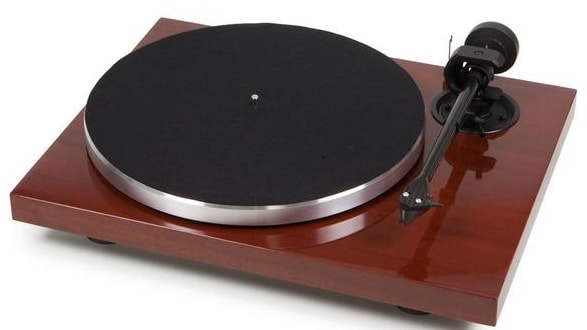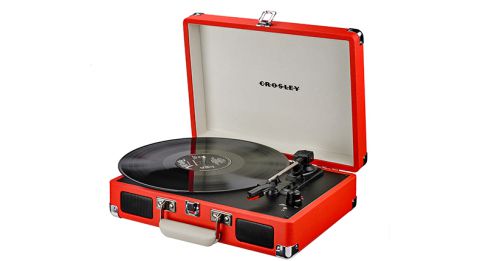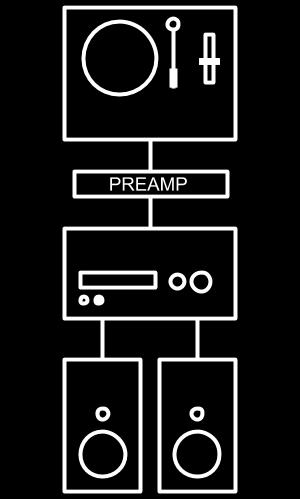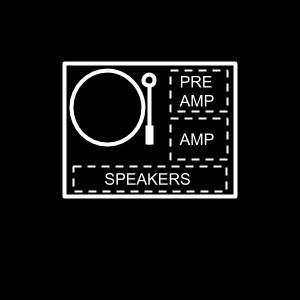One of the first things you will see when you are starting out with vinyl is that the device you put your records on is called both turntable and record player.
Confusing, right?
The terms turntable and record player are often used interchangeably, but there is actually a distinct difference.
A turntable is an assembly that includes the platter that spins the record and the tonearm/cartridge that picks up the music that is carved into the record. A turntable needs a separate preamp, amplifier and separate speakers to play records. It is not an all-in-one record playing unit.
Here is an example of a turntable.

You can review our list of best turntables in our 10 Best Turntables from $100 to $1000 article.
A record player is an all-in-one device that does not need any external components to play records. In a record player, the turntable, preamp, amplifier, and speakers are all bundled into one unit. And it is often portable.
And here is an example of a record player.

You can review our complete list of top rated record players in our 10 Best Portable Record Players with Speakers article.
Turntable explained
A traditional turntable setup needs a preamp, amplifier and speakers to play vinyl records, as shown in the figure below. Here, all the units are standalone components.

The turntable reads the grooves that are carved into the record and transform them to a small electrical signal called a PHONO signal.
The preamp boosts the tiny PHONO signal from the turntable so that it can be inputted to an amplifier or receiver. If there is a preamp built into the turntable or the amplifier, which is often is, then there is no need for a separate preamp.
The amplifier strengthen the signal further so that it becomes strong enough to drive speakers. Some speakers have the amplifier built-in and is called powered speakers.
The speakers converts the power amplified signal to music and the air.
The main components of a turntable are the plinth, the platter, the tonearm, the cartridge, and the speed selector. Depending on the model, there can be additional components, but these form the basic components of every turntable.
Plinth. Is the base of the turntable. The chassis if you like.
Platter. Is the part that spins. And holds the record.
Tonearm. As the part that holds the cartridge and moves it across the records as it plays. It is connected to the plinth on one end.
Cartridge. Holds the stylus and converts the movement of the stylus into an electrical signal.
Stylus. Or needle. “Digs” into the groves that are carved into the records and move with them.
Speed selector. Select the speed which the turntable spins. Enables the turntable to play 33 RPM, 45 RPM and sometimes, 78 RPM records.
Some turntables also include a preamp and outputs a LINE level signal. As apposed to the PHONO signal outputted from a turntable without a preamp.
A turntable with a built-in preamp can be connected to an amplifier/receiver directly, without having to connect a preamp between the turntable and the amplifier/receiver.
There are also some amplifier/receivers that come with built-in PHONO preamp and can be connected to a turntable without a built-in preamp directly.
On most turntables, there is possible to change and upgrade the stylus and cartridge. This comes in handy if the stylus is worn out or if you want to upgrade the cartridge to a higher quality one that produces higher quality sound.
Also, on most turntables, it is possible to adjust cartridge alignment, tracking weight (stylus downforce) and anti-skate. Correct adjustments are essential to make the turntable deliver it’s best
Record Player explained
In a record player, all the necessary components are bundled in one unit as shown in the figure below.

A record player includes a turntable, preamp, amplifier and speakers.
As everything is included, no extra boxes or cables are necessary to play records.
Usually, there are very few options to change/upgrade components or to fine adjust cartridge alignment and stylus downforce on a record player.
All this is usually fixed from the factory.
Which is better? Turntable or record player?
Better is kind of a subjective term. Different people will have different criteria for how to score that. But for almost all people in almost all situations, I think it still safe to say that a turntable is better.
Why?
I give you three main reasons for that?
1 – Build quality
The build quality of a record player is usually much poorer than the build quality of a turntable. Turntables are built to last. Record players are built to be cool, light, portable, have everything included and low priced. It would be very possible to manufacture a record player with good build quality, but the ones that dominate the market nowadays just isn’t. With the exception of the very lowest priced ones, turntables have better build quality than record players in general. And will last a lot longer.
2 – Sound quality
The sound quality of a record player is usually at the very lower end of the spectrum. The main problem is that the small built-in speakers (driven by a tiny amplifier) will under no circumstance be able to reproduce the lower tones (bass) in the music.
Furthermore, as most record players are built to be low cost, the quality of the built-in components (turntable, preamp, amplifier, and speakers) will have to be cheap, and hence, of low quality. This because using high-quality components would put the record player at a higher price point than most consumers are willing to pay for a record player in today’s market.
Even if you buy a very reasonably priced turntable with built-in preamp, and hook it up with a very reasonable set of active speakers (speakers with a built-in amplifier), the sound quality will exceed the sound quality of almost every consumer record player.
And with a turntable, you always have the options to connect it with higher quality components (preamp, amplifier, and speakers), which will give you all the options in the world to set up a stereo with really good sound quality. But, of course, you’ll have to spend more money this way.
3 – Wear and tear on records
If you have a record collection and want to take good care if it, please make sure to keep it well away from record players in any shape or form.
The reason being that as tracking weight (needle downforce) and cartridge alignment is usually fixed from the factory on record players. And unfortunately, often way off from the correct tracking force and alignment.
The recommended tracking force is usually around 2 grams of downforce. On record players this is often reported to be around 6 grams. Which is way too high!
In addition, the alignment of the cartridge (and stylus/needle) is often way off too.
This will make the war and tear of your records much higher than it should be and can potentially severely damage your records over time.
On a turntable, tacking force and alignment are almost always adjustable, giving you the option to make sure that the records are played with minimum wear and tear.
So a record player can’t be better than a turntable?
I think not.
It can be cheaper, cooler looking, easier to use and easier to carry with you, so it has upsides. But it cannot be considered to be better. If you have a Crosley Cruiser record player and love, I am so sorry, but I think that is just a fact.
What do record players and turntables cost?
There is a good selection of record players in the $50 to $100 range.
You will also find turntables in the $50 to $100 range, but to buy one that has the essential options to adjust tracking force and alignment, and the options to replace stylus and cartridge, you’ll probably have to spend around $200 and upwards.
A good quality mid-range turntable that will last forever and give good quality sound will, however, set you back from $300 to $500. And then you have to add the other stereo components in your turntable based stereo setup (preamp, amplifier, speaker).
And when it comes to turntables and cost, the sky is the limit. If you have $10000 to spend on a turntable you will have no problem finding plenty of options in the world of Stereophile craziness.
How to set up a turntable
If you want a detailed guide on how to set up a turntable, I will recommend this article that describes all the possible configurations with illustrations.
The short answer is, however, that you must make sure that all the four essential components of a vinyl playing stereo setup are present and connected correctly.
The four essential components being:
- Turntable
- Preamp (standalone or bundled with the turntable or amplifier/receiver)
- Amplifier/receiver (standalone or bundled with the speakers)
- Speakers
How to set up a record player
You connect it to power. And you are good to go.
Related questions
What is the difference between passive and powered speakers?
Passive speakers need to be connected to an amplifier/receiver to produce sound. They have no power amplifier built in. Powered speakers, on the other hand, have a built-in power amplifier. Powered speakers can be connected directly to a CD player or a DVD player. The can also be connected directly to a turntable if the turntable has a built-in preamp. Powered speakers need to be connected to power, while passive speakers don’t connect to power.
What is a preamp (or phono preamp or phono stage)?
A preamp amplifies the tiny PHONO signal that is generated in the turntable’s cartridge into what is called a LINE level signal that can be inputted to an amplifier/receiver or to active speakers. Simultaneously, the preamp significantly increases the lower tones (bass) and decreases the higher tones (treble). This because a vinyl record is produced with highly reduced bass and highly increased treble to enable more songs to fit at one record. As lower tones take up more space on a record (wider grooves), the lower tones are reduced before the record is carved to save space. This is then corrected in the preamp.